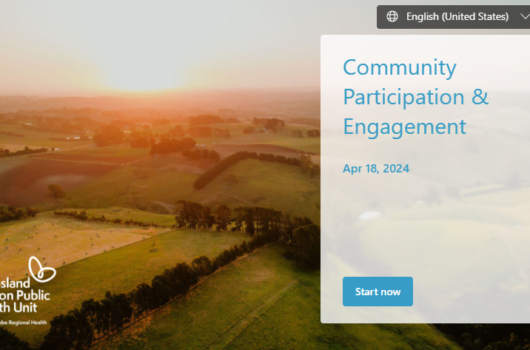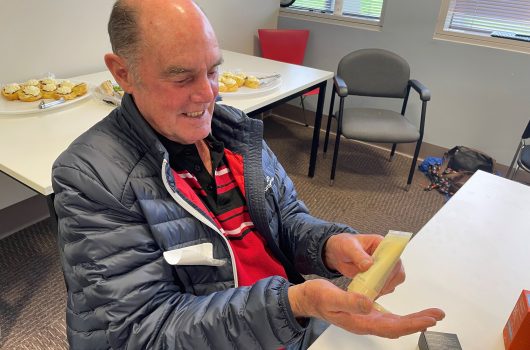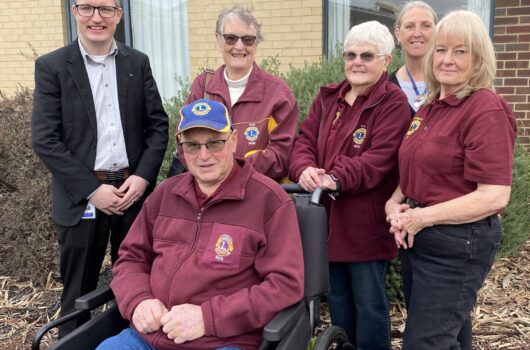Food safety and storage

| Information for communities impacted by power outages – February 2024 |
| OFFICIAL |
Contents
Power outages and food safety. 1
Take special care with high-risk foods. 2
Food poisoning – prevention. 3
Looking after your baby or young child without gas or electricity. 3
Preventing illness from contaminated water 3
Mental health – Trauma – reaction and recovery. 4
Mental health – services and support 4
Food poisoning is frequently caused by bacteria from foods that have been incorrectly stored, prepared, handled or cooked. Food contaminated with food poisoning bacteria may look, smell and taste normal. If food is not stored properly, the bacteria in it can multiply to dangerous levels.
Power outages and food safety
The most important thing is to try to keep cold and frozen food cold. If food is still cold to touch
(less than 5 °C), it is safe to use.
Food poisoning bacteria grow and multiply fastest in the temperature danger zone between 5 °C and 60 °C.
It is important to keep high-risk food out of this temperature zone.
During a power failure the following actions will keep frozen and cold food frozen or chilled for longer:
- Move food from the fridge to the freezer.
- If available, put bagged ice under food packages and trays stored in freezers and fridges if power failure lasts more than 1 hour.
- Place an insulating blanket over cold or frozen food, where possible.
- Only open fridge and freezer doors when absolutely necessary, this will keep the food and air temperature colder for longer.
- Choose foods that don’t require refrigeration, such as bread, spreads, fruit, vegetables and canned products.
- You could try extending the life of your perishables by storing them temporarily in an Esky or car fridge.
- If you have neither gas nor electricity, cook foods outside on the barbecue. Never use a barbeque inside a home, tent or caravan.
After a power failure
- Once cold or frozen food is no longer cold to touch, it can be kept and eaten for up to 4 hours and then it must be thrown away.
- Throw out high-risk food left in the temperature danger zone (between 5 °C and 60 °C) for more than 4 hours – don’t put it in the fridge and don’t keep it for later.
- If it is raw meat, it should be cooked and eaten.
- Eat hot food within 4 hours of it being heated or throw it away.
- If power is restored when frozen food is still frozen solid the food is safe. Your fridge temperature should be at 5 °C or below. The freezer temperature should be below -15 °C. Use a thermometer to check the temperature in your fridge.
- Avoid refreezing thawed food. Food that is frozen a second time is likely to have higher levels of food poisoning bacteria. The risk depends on the condition of the food when frozen, and how the food is handled between thawing and refreezing. Raw food should never be refrozen once thawed.
Medications
- Some medicines need to be refrigerated – if you leave them out of the fridge by accident or they freeze, check with your pharmacist whether they should be thrown out or used within a certain time.
More information:
https://www.health.vic.gov.au/food-safety/food-safety-during-power-outages#emergency-power-failures https://www.betterhealth.vic.gov.au/health/servicesandsupport/emergencies-coping-without-gas-or-electricity
https://www.betterhealth.vic.gov.au/health/healthyliving/food-safety-and-storage
Translated resources on health translations
Power outages: using alternative fuel and elec. generation safely
Power outages: food safety after a power failure
Take special care with high-risk foods
Food poisoning bacteria can grow and multiply on some types of food more easily than others. High-risk foods include:
- raw and cooked meat – such as chicken and minced meat, and foods containing them, such as casseroles, curries and lasagne
- dairy products– such as custard and dairy-based desserts like custard tarts and cheesecake
- eggsand egg products – such as mousse
- smallgoods – such as ham and salami
- seafood – such as seafood salad, patties, fish balls, stews containing seafood and fish stock
- cooked rice and pasta
- prepared salads – such as coleslaws, pasta salads and rice salads
- prepared fruit salads
- ready-to-eat foods – such as sandwiches, rolls, and pizzas that contain any of the food above.
Food that comes in packages, cans and jars can become high-risk foods once opened, and should be handled and stored correctly.
Food poisoning – prevention
There are some simple rules you can follow to minimise the risk of food poisoning.
When you prepare food
- Wash your hands in warm, soapy water and dry them well before preparing food. Wet hands are more likely to transmit bacteria so take the time to dry them thoroughly.
- Don’t use the same cutting board for raw food that will be cooked (such as meat) and foods served uncooked (such as salads). This reduces the chances of cross-contamination of food.
- If you don’t have separate cutting boards or utensils to prepare raw foods and ready-to-eat foods, thoroughly clean and dry them between each use.
- Note that most food should be cooked to a temperature of at least 75 °C.
- Check the cooking temperature with a thermometer. If you don’t have one, make sure you cook poultry until the meat is white, particularly near the bone. Cook hamburgers, mince, rolled roasts and sausages right through until their juices run clear. Cook white fish until it flakes easily with a fork.
- Rinse raw fruits and vegetables with clean water before using them.
- If you feel unwell, let someone else prepare the food.
When you store food
- Separate raw food from cooked food, and store raw food at the bottom of the fridge to avoid juices dripping onto, and contaminating, other food.
- Check your fridge temperature is below 5 °C and your freezer temperature is below -15 °C.
- Allow cooked foods to cool to room temperature (about 21 °C) before storing in the refrigerator. This should not take more than 2 hours – cooling will be quicker if you put hot food into smaller containers rather than leaving it in one large one. This prevents the refrigerator temperature from rising and reduces the risk of bacterial growth in all food stored in the fridge.
- Cover all food with lids, tin foil or plastic wrap.
- Don’t store food in opened tin cans.
Looking after your baby or young child without gas or electricity
Parenting without gas or electricity can be tricky, particularly where food preparation and hygiene are concerned. Suggestions include:
- Maintain personal hygiene after changing nappies or before handling food by washing your hands with soap and cold water.
- Use disposable instead of cloth nappies.
- If you can’t boil bottles, sterilise them in commercially prepared disinfecting solutions. Follow the instructions on the manufacturer’s label.
- Don’t use the microwave oven to warm up your baby’s bottle, as you risk scalding. It is fine to give your baby cold milk.
Preventing illness from contaminated water
Water used for drinking needs to be safe to prevent disease and ill health.
- Local water authorities will tell you if tap water is safe or unsafe to drink, use for cooking, cleaning or bathing.
- If the water is not safe, use bottled, boiled or disinfected water.
- An above ground rainwater tank that has not been inundated with floodwaters or damaged should be safe for continued use.
More information:
https://www.betterhealth.vic.gov.au/health/healthyliving/emergencies-floods#preventing-illness-from-contaminated-water
Mental health – Trauma – reaction and recovery
It is normal to have strong emotional or physical reactions following a distressing event. On most occasions though, these reactions subside as a part of the body’s natural healing and recovery process.
People can experience a range of physical, mental, emotional and behavioural reactions. For example,
- Mental reactions to trauma include: reduced concentration and memory, intrusive thoughts about the event, repeatedly playing parts of the event over in the mind, confusion or disorientation.
- Emotional reactions to trauma can include: fear, anxiety and panic, shock – difficulty believing in what has happened, feeling detached and confused, feeling numb and detached, not wanting to connect with others or becoming withdrawn from those around you.
- Behavioural reactions to trauma can include: avoiding reminders of the event, inability to stop focusing on what occurred, getting immersed in recovery-related tasks, losing touch with normal daily routines, changed appetite, such as eating a lot more or a lot less, turning to substances such as alcohol, cigarettes and coffee, sleeping problems.
- Seek professional help if you don’t begin to return to normal after three or four weeks.
More information
https://www.betterhealth.vic.gov.au/health/conditionsandtreatments/trauma-reaction-and-recovery https://www.betterhealth.vic.gov.au/health/healthyliving/talking-to-children-about-bushfires
Mental health – services and support
Sometimes it can be hard to know who to talk to if you are experiencing a mental health crisis. If you do not have family and friends living nearby or a strong local support network, it can be hard to get through difficult times on your own. Whether you are in a crisis or you just feel down and need to talk to someone, it is important to know that help is available at all hours of the day and night.
There are many free mental health hotlines and mental health online support services across Victoria, which provide crisis support, information, resources, counselling and therapy to people of all ages.
With the recent bushfires and storms, it is understandable if you are feeling concerned and experiencing a mix of strong emotions or physical reactions right now.
- Seeking help is a sign of strength and often the first step in recovery.
- Talk to neighbours, friends or family, your doctor, Lifeline on 131 114 or Beyond Blue on 1300 224 636.
- For more help and information please visit Better Health:
More information:
https://www.betterhealth.vic.gov.au/health/servicesandsupport/counselling-online-and-phone-support-for-mental-illness
https://www.betterhealth.vic.gov.au/servicesandsupport/trauma-recovery-services
Download this document as a PDF here.






